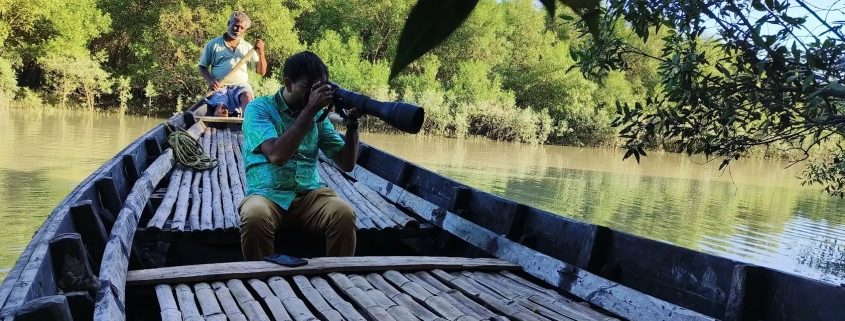- 1 Day Sundarban Tour
Pricing:
- ₹2799 per adult
- ₹1399 for children aged 4-8 years
- Free for children aged 1-4 years (under 48 months)
Facilities Included:
- Welcome Drink:
- Transportation: [Pick + Drop]
- Breakfast:
- Boat Safari:
- Lunch:
- Sightseeing:
- Guide Assistance:
- Snacks and Tea:
- Safety Measures:
- 1 Night 2 Days Sundarban Tour
Pricing:
- ₹4500 per adult (Non-AC room)
- ₹5000 per adult (AC room)
- ₹2250 for children aged 4-8 years
- Free for children aged 1-4 years (under 48 months)
Facilities Included:
- Welcome Drink
- Meals: All Times
- Boat Safari
- Accommodation: AC/ Non Ac
- Cultural Program:
- Visit Watchtowers and Local Attractions
- Safety
- Guided Tour
- Tea/Coffee Breaks
- 2 Night 3 Days Sundarban Tour
Pricing:
- ₹5500 per adult (Non-AC room)
- ₹6500 per adult (AC room)
- ₹2750 for children aged 4-8 years
- Free for children aged 1-4 years (under 48 months)
Facilities Included:
- Welcome Drink
- Meals: (breakfast, lunch, evening snacks, and dinner)
- Extended Boat Safaris: Multiple guided boat safaris
- Accommodation: in AC or non-AC rooms,
- Cultural Program:
- Visits to Key Attractions:
- Expert Guide:
- Tea/Coffee Breaks:
Sundarban 3 Days 2 Nights Package
Immerse in the wild beauty of Sundarbans with our 3 Days, 2 Nights adventure!
Book Sundarban 3 Days 2 Nights
Immerse in the wild beauty of Sundarbans with our 3 Days, 2 Nights adventure!
- 2 Night 3 Days Sundarban Boat Tour
Pricing:
- ₹5500 per adult (Non-AC room)
- ₹6500 per adult (AC room)
- ₹2750 for children aged 4-8 years
- Free for children aged 1-4 years (under 48 months)
Facilities Included:
- All Meals:
- Guided Boat Safaris:
- 2-Night Accommodation: Stay on the boat in comfortable AC or non-AC rooms.
- Cultural Performances:
- Attractions:
- Safety & Security:
Boat Sundarban 3 Days 2 Nights Package
Sail into the wild with our 3 Days, 2 Nights Sundarban Boat Adventure!
Sundarban 3 Days 2 Nights Package
Explore the untamed beauty of Sundarbans with a thrilling 3 Days, 2 Nights boat tour!
Best Time to Visit Sundarbans: A Seasonal Guide

Best season for Sundarbans: The Sundarbans, the world’s largest mangrove forest and a UNESCO World Heritage Site, offers an unmatched experience for nature lovers, adventure seekers, and wildlife enthusiasts. However, the best time to visit this enchanting ecosystem varies depending on your interests and the experiences you seek. This seasonal guide will help you plan your visit to the Sundarbans at the perfect time. We will discuss some more about “Best season for Sundarbans”.

Overview of Sundarbans Seasons
The Sundarbans experiences three main seasons:
- Winter (November to February): Cool and pleasant, the peak tourist season.
- Summer (March to May): Hot and humid, suitable for off-season travelers.
- Monsoon (June to September): Wet and lush, offering a unique perspective of the forest.
Winter (November to February): The Best Time to Visit
Why Visit in Winter?
Winter is the most popular time to visit the Sundarbans. The weather is mild, making it ideal for exploring the mangrove forests and spotting wildlife. Temperatures range between 10°C and 25°C, ensuring a comfortable journey.

Highlights of Winter Visits
- Wildlife Sightings: Spot Royal Bengal Tigers, spotted deer, crocodiles, and a variety of birds.
- Birdwatching: Winter brings migratory birds like herons, kingfishers, and storks.
- Boat Safaris: Navigate the waterways comfortably without the scorching heat.
- Festivals: Experience local cultural events and festivals like the “Poush Parbon.”
Read More:
Pro Tip:
Book your tour packages in advance as winter is the peak season, and accommodations fill up quickly.

Summer (March to May): For the Brave and Budget-Conscious
Why Visit in Summer?
Though summer is hot and humid, it’s an excellent choice for travelers seeking solitude and budget-friendly options. Temperatures range from 25°C to 40°C, and fewer tourists visit during this time.
Highlights of Summer Visits
- Tiger Spotting: The higher temperatures often drive tigers and other animals to the water bodies, increasing your chances of sightings.
- Peaceful Environment: Enjoy the tranquility of the forest without crowds.
- Budget-Friendly: Tour packages and accommodations are more affordable during the off-season.

Pro Tip:
Carry lightweight clothing, sunscreen, and plenty of water to stay cool and hydrated.
Monsoon (June to September): A Lush and Rainy Wonderland
Why Visit in Monsoon?
The monsoon transforms the Sundarbans into a lush green paradise. While the heavy rainfall and swollen rivers can make travel challenging, this season offers a unique and magical experience.
Highlights of Monsoon Visits
- Scenic Beauty: Witness the forest at its most vibrant, with rejuvenated flora and fauna.
- Romantic Getaway: The rain-soaked mangroves and waterways create a dreamy ambiance.
- Off-Season Perks: Enjoy lower prices and a serene environment with fewer tourists.
Pro Tip:
Check weather conditions and consult your tour operator before planning a monsoon visit. Opt for short tours and carry waterproof gear.
Best season for Sundarbans
| Interest | Recommended Season |
|---|---|
| Wildlife Safaris | Winter, Summer |
| Birdwatching | Winter |
| Scenic Photography | Monsoon |
| Budget-Friendly Trip | Summer, Monsoon |
| Cultural Experiences | Winter |
Plan Your Sundarbans Adventure
No matter which season you choose, the Sundarbans promises an unforgettable experience. For a seamless journey, book your trip with trusted operators like Royal Sundarban Tourism and Sundarban Leisure Tourism, powered by Argusdna.

Book Your Tour Now:
- Royal Sundarban Tourism
- Sundarban Leisure Tourism
- Powered by Argusdna: https://argusdna.com/












